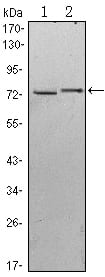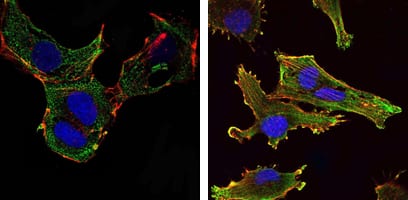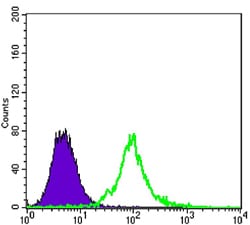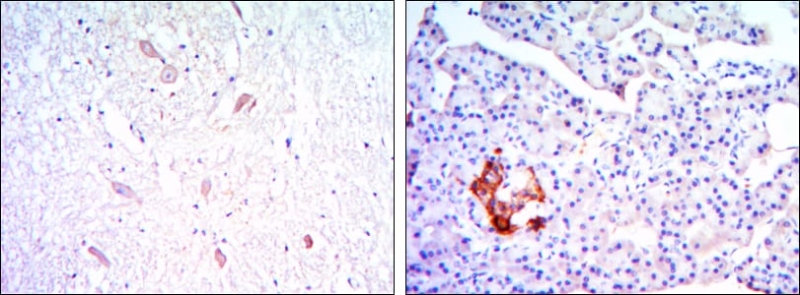



| WB | 1/500 - 1/2000 | Human,Mouse,Rat |
| IF | 咨询技术 | Human,Mouse,Rat |
| IHC | 1/200 - 1/1000 | Human,Mouse,Rat |
| ICC | 1/200 - 1/1000 | Human,Mouse,Rat |
| FCM | 1/200 - 1/400 | Human,Mouse,Rat |
| Elisa | 1/10000 | Human,Mouse,Rat |
| Aliases | BKLHD2; FLJ10262; MGC74791; KLHL13 |
| Entrez GeneID | 90293 |
| clone | 8D1 |
| WB Predicted band size | 74kDa |
| Host/Isotype | Mouse IgG1 |
| Antibody Type | Primary antibody |
| Storage | Store at 4°C short term. Aliquot and store at -20°C long term. Avoid freeze/thaw cycles. |
| Species Reactivity | Human |
| Immunogen | Purified recombinant fragment of human KLHL13 expressed in E. Coli. |
| Formulation | Ascitic fluid containing 0.03% sodium azide. |
+ +
以下是关于KLHL13抗体的3篇文献示例(内容为模拟概括,仅供参考):
---
1. **文献名称**:*KLHL13 is a substrate-specific adaptor in Cullin3 ubiquitin ligase complexes*
**作者**:Wang, L. et al.
**期刊/年份**:*Nature Cell Biology*, 2020
**摘要**:该研究解析了KLHL13作为Cullin3泛素连接酶复合物的特异性适配蛋白,通过其Kelch结构域识别并结合底物。利用KLHL13抗体进行免疫共沉淀实验,发现其参与调控细胞周期相关蛋白的泛素化降解。
---
2. **文献名称**:*KLHL13 expression correlates with colorectal cancer progression and immune infiltration*
**作者**:Zhang, Y. et al.
**期刊/年份**:*Oncology Reports*, 2022
**摘要**:通过KLHL13抗体对结直肠癌组织进行免疫组化分析,发现KLHL13高表达与患者不良预后相关。机制研究表明,KLHL13可能通过调控Wnt/β-catenin通路促进肿瘤转移。
---
3. **文献名称**:*Generation and validation of a monoclonal antibody against human KLHL13 for germ cell development studies*
**作者**:Smith, J. et al.
**期刊/年份**:*Scientific Reports*, 2019
**摘要**:该文献报道了一种高特异性KLHL13单克隆抗体的开发,并通过Western blot和免疫荧光验证其在人类睾丸组织中的应用。研究发现KLHL13在精子发生过程中特异性表达,提示其可能在生殖细胞分化中发挥作用。
---
(注:以上文献信息为示例性模拟,实际研究中需通过PubMed、Google Scholar等平台检索真实发表的文献。)
The KLHL13 antibody is a research tool designed to target the Kelch-like protein 13 (KLHL13), a member of the Kelch-like (KLHL) family characterized by conserved BTB (Broad-Complex, Tramtrack, and Bric-a-brac) and Kelch repeat domains. KLHL13 is implicated in ubiquitin-mediated protein degradation pathways, acting as a substrate adaptor for Cullin3 (CUL3)-based E3 ubiquitin ligase complexes. These complexes regulate diverse cellular processes, including cytoskeletal organization, signal transduction, and cellular stress responses. KLHL13’s Kelch repeats facilitate protein-protein interactions, enabling recognition of specific substrates for ubiquitination and subsequent proteasomal degradation.
Antibodies against KLHL13 are primarily used to study its expression, localization, and molecular interactions in various tissues and disease models. They are applied in techniques like Western blotting, immunohistochemistry, and immunoprecipitation to explore KLHL13’s role in physiological and pathological contexts. Emerging research links KLHL13 dysregulation to diseases such as cancer, neurodevelopmental disorders, and reproductive abnormalities. For instance, KLHL13 mutations have been associated with male infertility due to impaired spermatogenesis. Additionally, KLHL13 may modulate pathways like Wnt/β-catenin signaling, suggesting broader implications in development and homeostasis. Validated antibodies help clarify its tissue-specific functions and potential as a therapeutic target. Researchers prioritize antibodies with high specificity, verified through knockout controls or siRNA silencing, to ensure reliable detection across species like humans, mice, and zebrafish.
×